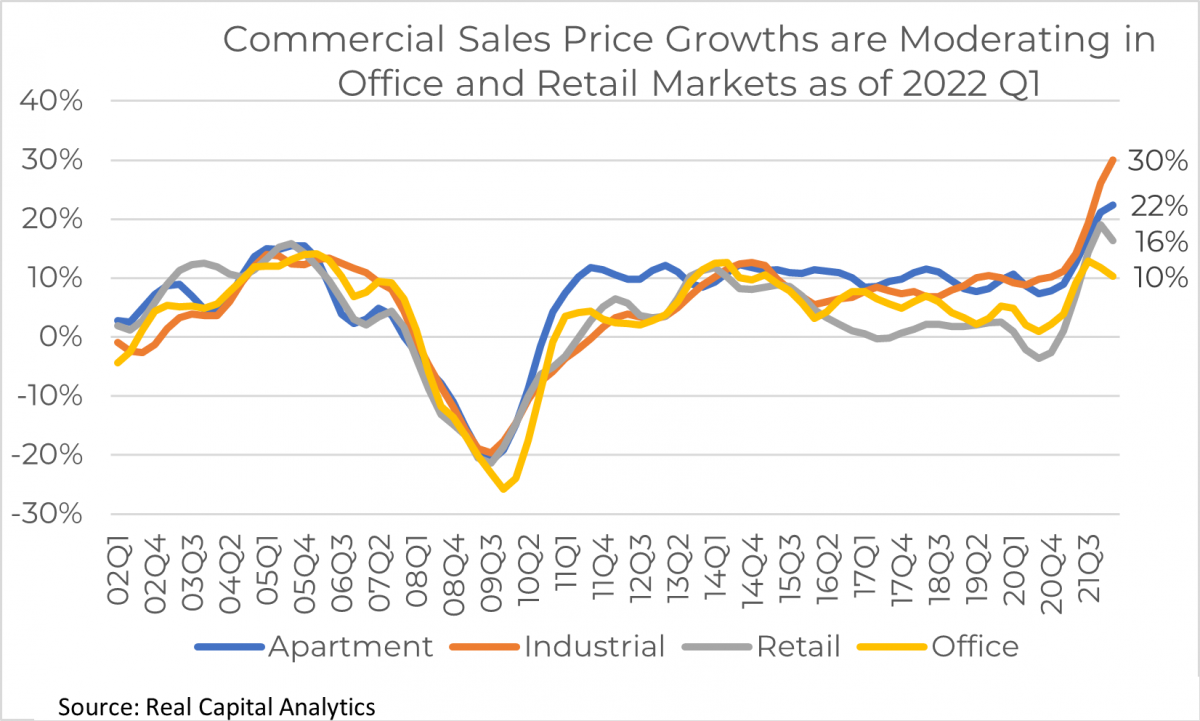Rising interest rates are likely to put some upward pressure on cap rates in 2022. However, the rise will be modest compared to the increase in the benchmark 91-day Treasury that has already increased by 1.3 percentage points as of the end of April from one year ago (2.7% as of April 26). This is because other factors are creating upward pressure on commercial real estate prices. The apartment market is likely to benefit from the higher mortgage rates due to increased demand for rental units. Reduced consumer spending will tend to lower the demand for industrial space but increased demand for warehouse space to minimize supply disruptions (just-in-case inventory management) could boost absorption. Inflation will hit consumer spending but retail stores providing essential services like the neighborhood centers will do better than retail stores providing non-essential services like high-end shopping malls. The continuing return to the office will also tend to minimize the decline in demand due to slower business formation.
Cap Rate Trends As of 2022 Q1
Cap rates continued to compress across all core property types as of the first quarter of 2022 Q1 even as the benchmark 10-year T-note spiked to 2.8% as of April from 1.5% one year ago. The risk premium, which is calculated as the nominal cap rate less the 10-year Treasury Note yield, continued to compress across all property types. Though interest rates have been rising amid mounting inflation and the Fed’s efforts to control inflation by raising the federal funds rate (with anticipated rate increases every quarter), investors are factoring in the strong demand for commercial assets and local economic conditions. Nationally, employment conditions continue to improve, with 20 million jobs recovered of the 22.5 million jobs lost during 2020, and on average, there are nearly 2 job openings for every job seeker.1
While cap rates are positively associated with the 10-year yield, cap rates don’t move in lock-step with it. For example, during the height of the pandemic in 2020 Q3, the risk spread for office and retail, which were the hardest hit assets after the economy went into a lockdown and many businesses remained closed, rose to as high as 6%. With an improving economy and the reopening of businesses, the risk-premium for office and retail assets has compressed to around 4%.
Because of the inverse relationship between cap rates and prices, the cap rate compression corresponds to a sharp rise in sales prices. As of 2022 Q1, office real estate prices are up 10% year-over-year on average while prices of retail real estate are up 16%. Industrial properties experienced the strongest price gain of 30% followed by apartment assets at 22%, according to the transaction-based commercial price indices reported by Real Capital Analytics.
Modest Cap Rate Increased in 2022
As of 2022 Q1, the apartment market had the lowest risk premium at 2.5% (3.5% one year ago). Cap rates are likely to continue to compress or hold steady for the apartment market. This is because rising mortgage rates will tend to encourage renters who would have been able to afford a home to remain renters. About 2.6 million renter households ages 25 to 44 years old have been priced out as mortgage rates rose from 3% to over 5%. Moreover, apartment assets are a good hedge against inflation as rents are adjusted annually. In a period of high inflation, investors will look for assets that yield positive returns. Currently, multifamily asking rents are rising 11% year over year2 while single-family apartment rents are up 13% year-over-year.3 With strong apartment demand, cap rates are likely to hover at 4.5% from the 2021 Q1 level of 4.4%. At the height of the pandemic in 2020 Q2, cap rates were at 5.2%.
Industrial cap rates have also trended downwards to 3.5% (4.3% one year ago). Absorption of industrial space is robust, with the vacancy rate at a low 4.1% and asking rents up 11% year-over-year, also resulting in real net rent growth. However, absorption has been tapered from about 150 million square feet (MSF) in 2021 to about 100 MSF as of 2022 Q2. Slower economic growth and high inflation are likely to slow consumer spending and manufacturing which will reduce the demand for industrial space. However, the shift from just-in-time inventory management to just-in-case inventory management as businesses seek to minimize supply chain disruptions could offset some of the decline in industrial space due to slower business formation. With a slight decrease in demand, cap rates are expected to tick up modestly to 5.7% from the current level of 5.3%. At the height of the pandemic in 2020 Q2, cap rates were at 6%.
Rising inflation will hit the retail sector the most, as consumers cut back on non-essential spending. However, neighborhood centers that are anchored around grocery stores are likely to do well. Moreover, the average vacancy rate is low, 4.5%, and this will tend to support commercial prices. But with slower consumer spending, cap rates are expected to rise to 6.3% from the current level of 6.1%. At the height of the pandemic in 2020 Q2, cap rates were at 6.6%.
In the office market, the vacancy rate in this property market remains elevated at 12%. However, the higher demand for office space as more workers return to the office is expected to moderate the decline in demand due to slower new business formation. Cap rates are likely to hover at 6.3% from the current level of 6.1%. At the height of the pandemic in 2020 Q2, cap rates were at 6.5%.
Source: “Commercial Cap Rates Likely to Keep Compressing in 2022 Despite Higher Interest Rates“





